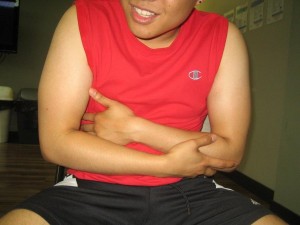Also known as pulled abdominal muscle, abdominal muscle strain is an 
Abdominal muscle strain normally comes about as a result of an overexertion of the stomach muscle, which can happen when doing an activity that the muscle is not ready for, when exercising excessively, improperly performing exercises or sports activities, sharply twisting the body or when lifting heavy objects.
Abdominal muscle strain Risk factors
Several factors increase an individual’s chances of developing abdominal muscle strain. They include not stretching appropriately before exercising, overexerting muscles, performing exercises and sports activities incorrectly, having weak back muscles, a person being fatigued, participating in vigorous activity and exercising in cold weather also increases the risk of the same. It is therefore necessary for a person to inform a doctor immediately in cases of these risk factors.
Abdominal muscle strain Symptoms
If one sees any of these symptoms, do not assume it is due to abdominal muscle strain as the symptoms may be caused by other conditions. Tell a doctor immediately should one feels pain when touching the affected area, muscle spasms, problems flexing or pain when stretching muscle, stiffness and discomfort and in severe cases, swelling or bruising.
Abdominal muscle strain Prevention
To help reduce the chance of getting abdominal muscle strain, the following steps should be taken: Stretch before exercising and cool down after, not overexerting oneself while exercising, getting proper training for sports and exercises. Performing exercises to strengthen abdominal muscles, working with a personal trainer or physical therapist, learning how to properly lift heavy objects and most importantly, if tired, stop exercising. In case one has a fever and abdominal pain, a doctor should be sought.
Abdominal muscle strain Treatment
Abdominal muscles strains are classified into Grade I (mild), Grade II (Moderate) and Grade III (severe). In case of mild strains, there may be a slight pain or discomfort but no disability. Grade II and Grade III strains may limit activities and cause moderate to severe pain, respectively.
When a person gets this kind of injury, there are several treatment procedures that he should follow. These include: after the injury, stop the activity right way, rest as needed then apply a cold pack for about 20 minutes. Apply ice four times a day for two days. At this stage, one can take pain medications as prescribed by a doctor to reduce swelling. Begin moderate stretching when ache subsides but if you do not improve in 1-2 days, call a doctor and ask him when you can return to normal activity. When symptoms of abdominal muscles strain begin to subside, perform exercises to slowly regain strength, use heat when returning to activity.